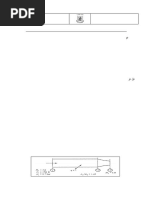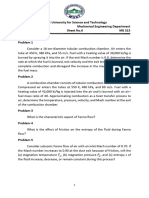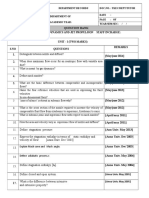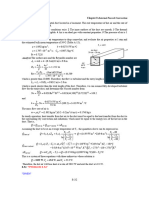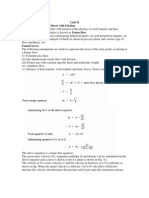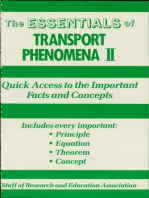0 ratings0% found this document useful (0 votes)
9 viewsUnit 4 Qa
The document contains 8 questions about Fanno and Rayleigh flow through pipes including calculating exit conditions given inlet conditions, deriving expressions for temperature, pressure, and density ratios in terms of Mach number under both Fanno and Rayleigh flow conditions.
Uploaded by
Naveen NaviCopyright
© © All Rights Reserved
Available Formats
Download as DOCX, PDF, TXT or read online on Scribd
0 ratings0% found this document useful (0 votes)
9 viewsUnit 4 Qa
The document contains 8 questions about Fanno and Rayleigh flow through pipes including calculating exit conditions given inlet conditions, deriving expressions for temperature, pressure, and density ratios in terms of Mach number under both Fanno and Rayleigh flow conditions.
Uploaded by
Naveen NaviCopyright
© © All Rights Reserved
Available Formats
Download as DOCX, PDF, TXT or read online on Scribd
You are on page 1/ 1
Unit-4
Fanno and Rayleigh flow
QA
1. Consider the flow of air through a pipe of inside diameter = 0.15 m and
length = 50 m. The inlet flow conditions are M1 = 0.2, p1= 1 atm, and T1 =
273 K. Assuming f = const = 0.005, calculate the flow conditions at the exit,
M2, p2, T2 and p02.
Ans: T01= 275.2 K, T01= 1270 K , M2 = 0.58, T2 =1183 K, p2 = 0.718 atm
2. Consider the flow of air through a pipe (flow with friction or Fanno flow) of
inside diameter = 15 cm and length = 150 cm. The inlet flow conditions are
M1 = 3, p1= 1 atm, and T1 = 300 K. Assuming f = const = 0.005, calculate the
flow conditions at the exit. M2, p2, T2 and p02.
3. Air enters a constant-area duct at M1 = 3, p1 = 1 atm, and T1 = 300 K. Inside
the duct, the heat added per unit mass is q = 3 x 105 J/kg. Calculate the flow
properties M2, p2, T2 , ρ2 p2, T02 and p02.at the exit of the duct.
4. Derive the expression for temperature ratios in terms of Mach number for
Fanno flow condition. State the assumptions made.
5. Derive the expression for pressure ratios in terms of Mach number for
Fanno flow condition. State the assumptions made.
6. Derive the expression for density ratios in terms of Mach number for
Fanno flow condition. State the assumptions made.
7. Derive the expression for temperature ratios in terms of Mach number for
Rayleigh flow condition. State the assumptions made.
8. Derive the expression for pressure ratios in terms of Mach number for
Rayleigh flow condition. State the assumptions made.
You might also like
- Me 6604 Gas Dynamics and Jet Propulsion Question BankNo ratings yetMe 6604 Gas Dynamics and Jet Propulsion Question Bank12 pages
- Convection Heat Transfer (III) - DPP-09 - GATE Crash Course 2023 MechanicalNo ratings yetConvection Heat Transfer (III) - DPP-09 - GATE Crash Course 2023 Mechanical7 pages
- Internal Forced Convection: "!PROBLEM 8-54"No ratings yetInternal Forced Convection: "!PROBLEM 8-54"10 pages
- SPC 407 Sheet 5 - Solution Compressible Flow - Rayleigh FlowNo ratings yetSPC 407 Sheet 5 - Solution Compressible Flow - Rayleigh Flow11 pages
- ME6604 Gas Dynamics and Jet Propulsion TutorialNo ratings yetME6604 Gas Dynamics and Jet Propulsion Tutorial10 pages
- Gas Dynamics and Jet Propulsion: Faculty of Engineering B.Tech. - Mechanical EngineeringNo ratings yetGas Dynamics and Jet Propulsion: Faculty of Engineering B.Tech. - Mechanical Engineering8 pages
- Cp502 Advanced Fluid Mechanics: University of Peradeniya Faculty of EngineeringNo ratings yetCp502 Advanced Fluid Mechanics: University of Peradeniya Faculty of Engineering2 pages
- Fundamentals of Gas Dynamics (NOC16 - ME05) Assignment - 3: SolutionsNo ratings yetFundamentals of Gas Dynamics (NOC16 - ME05) Assignment - 3: Solutions4 pages
- Unit II Flow in Constant Area Ducts With FrictionNo ratings yetUnit II Flow in Constant Area Ducts With Friction32 pages
- Final Exam Compressible Fluid Flows: 50 Marks 120 MinutesNo ratings yetFinal Exam Compressible Fluid Flows: 50 Marks 120 Minutes2 pages
- ME4202501 Thermodynamics I, Fall Term 2015 Practice 6No ratings yetME4202501 Thermodynamics I, Fall Term 2015 Practice 61 page
- Mahendra Adhi K 23114310: Advanced Fluid MechanicsNo ratings yetMahendra Adhi K 23114310: Advanced Fluid Mechanics5 pages
- First Internal Assessment Test, Feburuary 2015: Me - 2351 Gas Dynamics and Jet PropulsionNo ratings yetFirst Internal Assessment Test, Feburuary 2015: Me - 2351 Gas Dynamics and Jet Propulsion1 page
- GATE 2023 ME Answer Key & Solutions Memory Based QuestionsNo ratings yetGATE 2023 ME Answer Key & Solutions Memory Based Questions45 pages
- Aerospace: Numerical Simulation of The Anti-Icing Performance of Electric Heaters For Icing On The NACA 0012 AirfoilNo ratings yetAerospace: Numerical Simulation of The Anti-Icing Performance of Electric Heaters For Icing On The NACA 0012 Airfoil15 pages
- (WWW - Entrance-Exam - Net) - KU, Aerospace Engineering - Introduction To Aerospace Engineering Sample Paper 1No ratings yet(WWW - Entrance-Exam - Net) - KU, Aerospace Engineering - Introduction To Aerospace Engineering Sample Paper 11 page
- Numerical Simulation of Transonic Flow Past A Cropped Delta WingNo ratings yetNumerical Simulation of Transonic Flow Past A Cropped Delta Wing6 pages
- Better Geometrical Solutions To Convert Microscopic KE To Macroscopic Kinetic Energy To .No ratings yetBetter Geometrical Solutions To Convert Microscopic KE To Macroscopic Kinetic Energy To .24 pages
- Measurements of The Near Wake of A Rotor in Forward Flight: AIAA 98-0692No ratings yetMeasurements of The Near Wake of A Rotor in Forward Flight: AIAA 98-069210 pages
- Mangalore Institute of Technology & Engineering, MoodabidriNo ratings yetMangalore Institute of Technology & Engineering, Moodabidri2 pages
- Pes Institute of Technology Bangalore - South CampusNo ratings yetPes Institute of Technology Bangalore - South Campus7 pages
- Mangalore Institute of Technology & Engineering, MoodabidriNo ratings yetMangalore Institute of Technology & Engineering, Moodabidri2 pages









